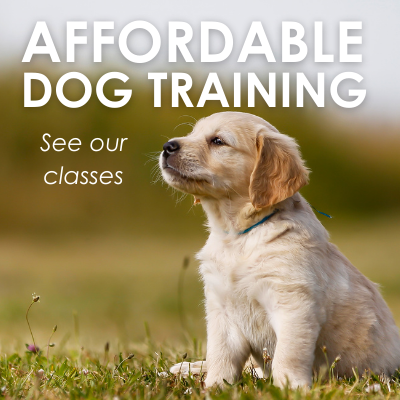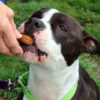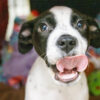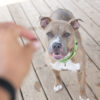Having a baby changes everything, for everyone – including the family dog.
As children come into our lives there are myriad changes in how we spend our time, how much time we have, how our homes are organized – just for starters! This piece is intended as a broad overview of things to consider before your baby is due and right after your baby arrives. While your dog may have spent time with babies, there are big differences in bringing a newborn home and then having a child in your home 24/7 – for all of you.
Preparing the dog before the baby’s arrival helps to increase safety and helps reduce our stress overall. Even the most easygoing dogs and their owners benefit from pre-baby preparation.
Ideally, you should start preparing your dog for baby when you find out you are pregnant – the sooner you begin, the better. Consider the following:
Before Baby
8 weeks before due date:
· Practice having your dog sit for people coming in the door while you hold a doll.
· Begin walking your dog with a stroller
· Brush up on your dog’s obedience skills
6 weeks before due date:
· Call dog sitters and arrange for care while you are at the hospital
· Add sitters’ names to your Hospital Contact list.
· Put up X-pens and baby gates in appropriate areas
· Begin confinement practice: Put your dog in the confinement area for 10-15 minutes with a stuffed Kong or chew bone.
5 weeks before due date:
· Create dog care instructions for your sitter and include your vet’s name and number.
· Call dog walkers and schedule interviews
· Give your dog a stuffed Kong on his mat while you read a book in the nursing chair
4 weeks before due date:
· Choose a dog walker and add him or her to your Hospital Contact list.
· Finalize dog walking schedule
· Put a doll in the baby swing and have your dog practice doing a stay on his mat.
3 weeks before due date:
· Hide your house keys in a safe location for your dog sitter or be sure they have an extra set.
· Create dog care instructions for your dog walker and include where your dog should be left if you are not at home when your dog is returned.
2 weeks before due date:
· At this point, you may want your dog to begin his schedule with the dog walker.
· Schedules are great for babies and dogs. Try to anticipate and practice your new daily routine and to get your dog accustomed to a little less of your attention.
1 week before due date:
· Take a deep breath and relax.
Questions to Answer Before Baby:
Nursery: Will your dog be allowed in the nursery?
No? Buy a baby gate and block your dog’s access to the room now.
Yes? Choose a safe spot for your dog to hang out and place a doggie mat or bed there.
Living room: Will your dog be allowed on the furniture once baby arrives?
If no, and he currently is, make the change now.
If yes, where will your dog be while you are on the couch with the baby?
Also consider where baby’s toys will be stored and where your dog’s toys will be stored.
Bedroom: Will your dog be sleeping in your bedroom?
No? If he currently does, make the change now.
Yes? Will he be on a dog bed? In a crate? Then make the change now.
Kitchen: Will your dog be allowed in the kitchen during mealtimes?
No? Where will he be? Is a baby gate needed?
Yes? Where will he be and what will he be doing?
Bringing Baby Home: Safe homecoming guidelines
- Homecomings with baby should be calm, quiet, and controlled.
- There is no need for a formal introduction or physical contact between dog and baby. When Mom and baby come home for the first time, the dog may be most excited to see Mom and may be curious about the baby (or not). Bringing home the baby is very exciting for us, but it doesn’t have to be an exciting event for the dog. In the event that the dog is anxious, or parents are concerned – meetings can wait – for a few days or even a few weeks.
- Mom should greet the dog first without without the baby.
- The baby, in a carrier, should be up on a table top or counter, away from the dog or held by another adult – not placed on the floor or on furniture where the dog may be able to access the baby. If the dog is curious about the baby, parents may want to let them “meet” in a very limited and controlled manner by allowing the dog to sniff the baby’s feet – but only under direct adult supervision (with an adult holding the baby in the adult’s lap) If there are concerns about the dog jumping up, consider putting the dog on a leash or having the dog drag a leash which can be picked up or stepped on if the dog is overenthusiastic. Again, sniffing the baby’s feet is a responsible safety precaution. All dogs have teeth – we want to keep those teeth away from baby’s face and head. If your dog is choosing not to interact with your baby, the dog is very likely anxious and worried. Forcing interaction won’t build trust and may result in unwanted interaction (growling, snapping, lunging from the dog). There’s no need to rush any introductions. Be aware of typical baby behaviors and elements (crying, high-pitched noises, babbling, new smells!) and note how your dog may be responding to you and your baby in the early days and weeks.
- Please note that newborns, awake or asleep, may be at risk for serious bites from dogs where the dog’s behavior resembles predation.
- Warning signs, if any, include the following behavior in dogs:
– Hyper-alertness (the dog has an intense focus on the infant)
– Ears forward/up
– “Muzzle punching” or “poking” at the infant with a closed mouth
– Whining, high-pitched barking
– Circling and/or jumping up. (Source: Ilana Reisner, DVM – see linked article at the end of this post)
– Should you note ANY of these, do not allow your dog access to your baby – immediately seek help from a qualified trainer and contact your veterinarian.
Supervision
A lack of supervision, absent supervision, or reactive supervision are the most common mistakes families make. But what does supervision mean?
Learning to read dog body language is a critical part of supervision. We can’t “supervise” what we can’t identify or see. We also have to be “present”. We live in a world full of distractions with electronic gadgets and media; if we’re engrossed in reading, focused on a TVshow or looking at our phones, it’s easy to lose track of things. Parenting tiny humans is also exhausting. Lack of sleep can negatively impact our ability to provide proper supervision.
When dogs and babies, dogs and kids are together – they need our full, awake attention. Things to be aware of:
- If we put the baby down for a nap: where is the dog?
- Is the baby’s sleep environment accessible to the dog?
- If we need to take a shower, go to use the bathroom ourselves, or we’ve walked out to the kitchen for something to drink: where is the baby and where is the dog?
Employing a management strategy such as separating the dog behind a baby gate or in a crate becomes very important. This becomes even more important as your baby is more mobile and can move toward your dog and into the dog’s personal space. If you have to leave the room, even just to go to the bathroom, separate dog and baby with a physical barrier. You should also be sure to stress to babysitters and other caregivers that they must have the same diligence about not leaving baby and dog alone together. Ever.
Your dog should NEVER have access to your baby without full, awake, adult supervision.
This chart from Family Paws Parent Education identifies five types of supervision. Use Proactive and Active Supervision with kids and dogs – planning and preparing, full awake adult supervision for safety.
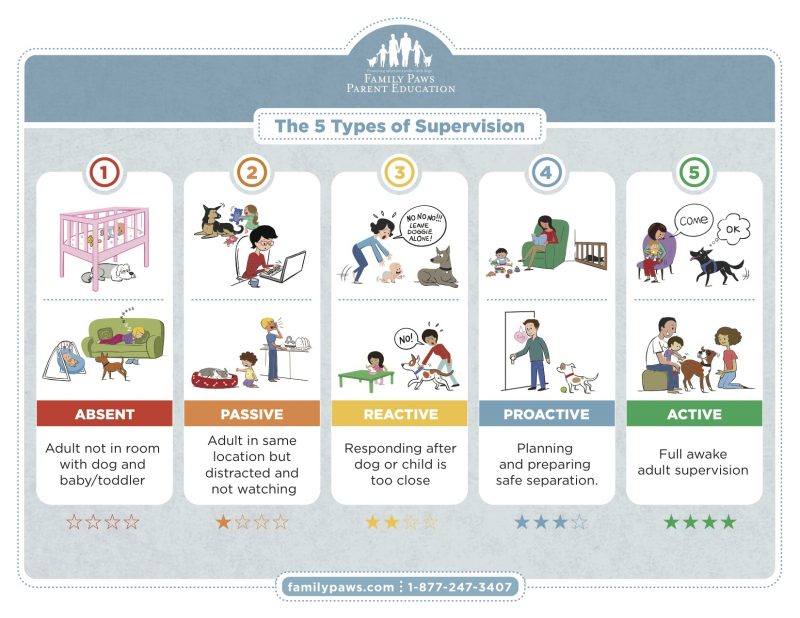
What can others do to help?
- Walk the dog
- Stuff food dispensing toys for the dog and freeze these
- Play games with the dog
- Feed the dog
- Hold baby while you interact with the dog
- Help with household chores: do a load of laundry; load/unload the dishwasher
- Prepare a meal or two – perhaps to freeze for hectic evenings
- Run errands
- Stay at your home with a napping baby while you take a walk with the dog
Moving forward
Many people spend time focusing on baby’s arrival, but the most stressful time for many families is typically during the time when your baby is 3- 6 months old and can begin to reach into the dog’s space. Dogs who seem comfortable with a newborn, can quickly become concerned as baby becomes more mobile – and this often means before the baby is crawling or walking.
“Babies grow and dogs age, and we have to adjust with every stage.”
~ Family Paws Parent Education
The baby’s new mobility may make the dog nervous as baby moves and interacts with the dog in new ways. The uncoordinated movements of a new walker are often worrisome for the most patient of dogs.
Keep in mind that if you have an issue in your home, meaning that you are concerned for your child’s safety, we strongly suggest that you contact a qualified trainer who uses dog-friendly, positive reinforcement approaches. A qualified trainer can help evaluate the situation and develop a training plan designed to keep everyone safe. Please research any professional who enters your home.
There are big differences between having a pet and parenting with a pet. There can be challenges in the process. Be patient with yourself and your dog.
Your relationship with your dog will change after baby arrives. There will likely be missteps and bumps in the road. The good news is that there are many resources available today that look at preparing and helping the family dog to successfully live with kids. Several of these are shared below.
Learn more
Family Paws Parent Education – Dogs & Storks® and Dogs & Toddlers programs
Dog and Baby Support Hotline 1-877-247-3407
Dogs and Babies Learning to Live Happily Ever After – Madeline Gabriel blogs
I Speak Dog – a site teaching why dogs do what they do and how to read dog’s body language to understand their emotional states
Living with Kids & Dogs – by Colleen Pelar – online and print resources, including the book Living with Kids and Dogs without Losing Your Mind – A Parent’s Guide to Controlling the Chaos
Good Dog in a Box – – helping families improve their lives with and for their dogs – online resources and products – many free to download
Doggone Crazy – A non-profit organization dedicated to dog bite prevention
Also see our article Children and Dogs – Important Information for Parents
About the author
Cathy Reisfield is a parent, grandparent, former clinician, and a nearly 20-year veteran in the field of dog training. She is the founder, head trainer and parent educator at Dependable Dogs® and the non-profit Kids & Dogs:Safer Together. She is also a licensed educator for the Family Paws programs, a member of the Safe Kids Huron Valley coalition, the Washtenaw Council for Children Safe Sleep Task Force,
and works with a variety community agencies to educate families and promote injury prevention. Cathy shares her home with her husband of 30+ years and 2 silly Labrador Retrievers.
Reprinted with permission from Cathy Reisfeld





